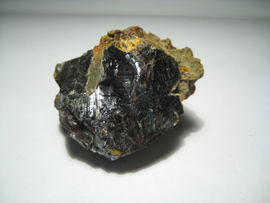Lead(II) sulfide
 Galena, a PbS ore
| |
| Names | |
|---|---|
| IUPAC name
Lead(II) sulfide
| |
| Other names
Galena
Lead monosulfide Lead(II) sulphide Plumbous sulfide Sulphuret of lead | |
| Properties | |
| PbS | |
| Molar mass | 239.30 g/mol |
| Appearance | Black or gray solid |
| Odor | Odorless |
| Density | 7.60 g/cm3 (20 °C) |
| Melting point | 1,118 °C (2,044 °F; 1,391 K) |
| Boiling point | 1,281 °C (2,338 °F; 1,554 K) |
| Insoluble | |
| Solubility | Insoluble in organic solvents |
| Vapor pressure | ~0 mmHg |
| Thermochemistry | |
| Std molar
entropy (S |
91.3 J/mol |
| Std enthalpy of
formation (ΔfH |
–98.7 kJ/mol |
| Hazards | |
| Safety data sheet | Sigma-Aldrich |
| Related compounds | |
| Related compounds
|
Lead(II) oxide |
| Except where otherwise noted, data are given for materials in their standard state (at 25 °C [77 °F], 100 kPa). | |
| Infobox references | |
Lead(II) sulfide is an inorganic compound with the formula PbS.
Contents
[hide]Properties
Chemical
Lead(II) sulfide can be roasted in air at high temperatures to form lead(II) oxide and sulfur dioxide. Lead oxide can be further reduced with carbon to lead metal.
- 2 PbS + 3 O2 → 2 PbO + 2 SO2
- PbO + C → Pb + CO
- 2 PbO + C → 2 Pb + CO2
Physical
Lead(II) sulfide is a black solid, insoluble in all solvents.
PbS is a semiconductor and was one of the earliest materials to be used as a semiconductor.
Availability
Lead sulfide is sold by chemical suppliers.
Lead(II) sulfide occurs naturally as the mineral galena.
Preparation
Lead(II) sulfide can be prepared by introducing hydrogen sulfide to a solution of lead(II) acetate.
- Pb(CH3COO)2 + H2S → PbS↓ + 2 CH3COOH
Projects
- Mineral collecting
- Make lead metal (Dangerous!)
- Make infrared detector
- Make black pigment
Handling
Safety
Lead(II) sulfide is so insoluble that it is almost nontoxic, but pyrolysis of the material, as in smelting, gives dangerous lead oxide fumes.
Storage
In closed bottles. Galena crystals can be placed in a frame and placed in a place of choice.
Disposal
Lead wastes should be taken to disposal centers.
